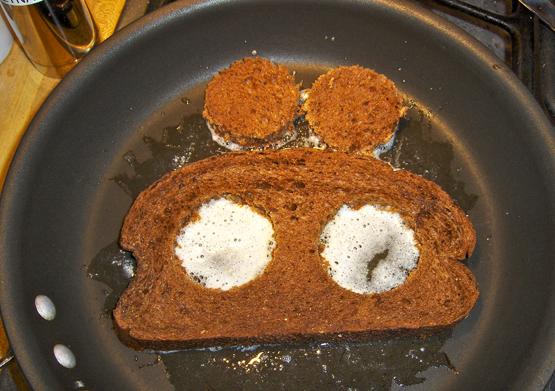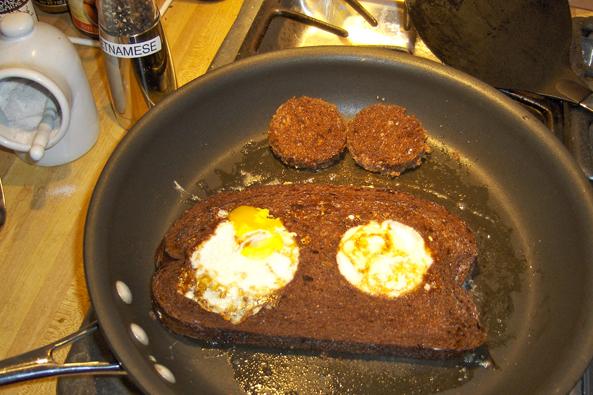-
Posts
11,033 -
Joined
-
Last visited
Content Type
Profiles
Forums
Store
Help Articles
Everything posted by andiesenji
-
Then I don't understand your premise. If you don't consider porridge a dish then it is difficult to narrow it down and get a clean time line. The next oldest item would be "stew" which is certainly a "dish" that would consist of several ingredients, seasonings, etc., not much different than we prepare today. Meat, fish or fowl, onions, roots (turnips, etc.), pulses, greens and herbs cooked together. Cathy Kaufman's Cooking in Ancient Civilizations has a number of early recipes and modern equivalents.
-
My all-time favorite breakfast. Gashouse eggs in Prairie Bread Semi-browned butter Eggs applied Eggs partially cooked Turned over, burner turned off.
-
While I love my Vita Mix and have been using them for 40 years, I'm not convinced that processing raw foods makes any nutrients more available. If someone has poor dentition, can't chew properly or has other problems, I can see that digestion might be helped by more break down of the foods. Certainly there are nutrients that are lost in prolonged cooking. I take all these claims with a grain (or more) of salt. I know many vegans and somewhat rabid vegetarians who are emphatic about the claims but I don't notice that they are a great deal healthier than anyone else who eats a balanced diet. That being said, I think the high powered blenders certainly do a better job and there is no question that they outlast the less powerful types by a huge factor. The initial outlay is significant but if you have to replace the cheaper ones often, you end up paying more in the long run.
-
I still think it would be porridge. The ancient Egyptians in the first dynasty - 5000 years ago - already had a long established system of feeding "municipal" workers with porridge made of grains, etc., as well as beer and bread. In North America, there is recent evidence that the earliest "immigrants" such as the Clovis People, gathered and made something like porridge from grains(millet) and acorns and the recent findings indicate they were doing this 14,000 years ago. Some Native Americans still prepare a similar dish. Frumenty was a porridge made from oats in medieval times but it probably arrived in England with the Romans, however the Romans were rather late to the table as far as porridge is concerned.
-
For the basic inline filters you don't need to drill a hole in your sink. The filter goes onto the cold water line under the sink and you can take it out and take it with you when you move. In my office, we had a reverse osmosis filter under the sink in the lab and when we moved to a new office we took it with us and put the original line back as it was. Such an installation is not considered a "permanent" fixture. Wow! I looked at the installation instructions of the basic model of the link you provided, and it seemed like they were intending you to permanently install the included spigot. Maybe, instead of the spigot, I could use a hose/valve that I could stash under the sink when not in use? Is that what you're talking about? Otherwise, did the RO filter connect in between the cold water line/regular faucet full time? Look at various brands of inline filters. most simply connect to the cold water line that goes to your sink faucet so when it is turned just to cold you get filtered water. If you have a single control "mixer" some filtered water will be mixed with the hot but it isn't a huge draw on the filter. You shouldn't need a separate hose or a separate delivery system, just the regular faucet. I'll look for the site that has detailed drawings for installing various types of filters. I know I have it bookmarked somewhere, just can't find it right now.
-
Jaymes ! THANK YOU ! I thought I was either loosing my mind or totally becoming a wimp ! Seems most red onions these days are hotter than the whites/browns/yellows. About a quarter of the time around here I can find them that are sweet, but not as sweet as I remember. The rest of the time they are mind-blowers. I always taste before throwing them willy-nilly into my salads. And it's a crapshoot. I can't tell by look or feel which is going to be nice and mellow and which is going to blow the top of my head off. Here's a "trick" to solve that problem. Cut your onions however you are going to use them, arrange in a shallow bowl and pour in some milk. Stir them to be sure they are all in contact with the milk and let them soak for 20-30 minutes. Rinse well in a colander, dry and use in your salads. It's amazing how well this method tempers onions that have too much "bite."
-

The Food Saver/Vacuum Sealer Topic, 2011 to Present
andiesenji replied to a topic in Kitchen Consumer
I'm glad you bumped this topic up. I got some info and forgot to post it. One of my friends has a unit with the tubing attachment and bought a needle valve - he got it at a hobby store - which is like the things we used to use to inflate basketballs, etc. It came with the fitting so he could attach it to the tubing and he just drills a tiny hole in the metal lids to admit the needle, surrounds the needle with the silicone sealer (food grade) vacuums it and withdraws the needle. He says that once the silicone has set, it is possible to open the jar, reseal and revacuum it without needing to add more sealant. He says the sealant is made by Tundra. -
Unless you need the greater capacity of a commercial unit, the Excalibur is still, in my opinion, the best you can buy. I have two of the 2900s which have had a lot of use for many years. The 2900 has a 5-year warranty. The 3000 series have a 26-hour timer and a 10-year warranty. Excalibur Dehydrators and they are made in the U.S.A. I started out twenty years ago with the 5-tray model which was larger than the other brands but soon found I needed the larger 9 tray and later added another. It is versatile in that you can remove the trays completely and use it for proofing dough and other tasks for which a temp lower than your oven is desired. I have one out in the garden shed used mostly for drying herbs because they can scatter easily once dried and the clean up is easier.
-
Also, these only work with standard faucets. If you have one of the pull-out faucets or one of the high volume faucets,or if your water pressure is above a certain level, they won't work.
-
For the basic inline filters you don't need to drill a hole in your sink. The filter goes onto the cold water line under the sink and you can take it out and take it with you when you move. In my office, we had a reverse osmosis filter under the sink in the lab and when we moved to a new office we took it with us and put the original line back as it was. Such an installation is not considered a "permanent" fixture.
-
I save turkey fat in the freezer and when I have a turkey breast to cook, I use my larding needle, fill it with the (defrosted) turkey fat and insert two lines of fat linearly in the approximate center of the breast half about 2 inches apart. If I'm not cooking for people who don't or won't eat pork, I sometimes use pork fat, unsmoked, and have also used beef suet if I don't have enough turkey fat. I have also used duck fat, which is a whole 'nother story. During roasting the fat is almost completely rendered and distributed in the flesh.
-
I use the locally grown "brown" onions in most applications because they have a hearty, true onion flavor that is not lost in prolonged cooking. I use the "Spanish" yellow onions for caramelized onions or onion marmalade. I use white onions in some dishes. I use red onions in salads, pickles and similar applications. There is one grower here in the Antelope valley that raises the Italian "torpedo" red onions and they are only available for a short time, usually September/October in the local produce market. The rest of the crop goes to restaurants, hotels and etc. These latter onions are much different than regular red onions. They are stronger, hotter and have a very robust flavor. I slice and dry them because they don't lose much flavor when dried. I use them in dishes where I want a lot of distinct onion flavor - meatloaf, braciola, etc.
-
Regarding dry venison - or other game. Get a Larding Needle I use "fat back" that I buy at the Mexican market - the salt pork sold in the regular markets is too salty for my taste. Anyway, you push the hollow needle into the pork fat and the "plunger" is pushed up to the top. You then stab it into the venison (or other meats that tend to be dry) and holding the lever on the side, pull the needle out, leaving the fat inside the meat. It makes an enormous difference in the texture and flavor of the meat. I sometimes cook for people who don't eat pork so for them I buy the beef suet for the same process. For turkeys that tend to have dry breast meat, you can take the excess turkey fat and using the needle, insert it in a couple of places in the center of the breast meat. If you already have one and use it, please excuse my presumption. P.S. This type of needle is much easier to use than the ones where you have to pull the fat through the meat. I've got both and this one is a cinch to use.
-
If you add up the cost of replacing filters, it is cheaper by far to get an in-line system to filter the water to just your kitchen sink. You have a one-time cost for the installation and the filters generally are good for two to three years, depending on how much you use. inline undercounter filter systems I have two of these type filters, one on the water supply to my icemaker and one to the refrigerator with icemaker since I had the whole house filter removed. The plumber charged me 146.00 for plumbing in both - I bought the systems myself. Some you can install yourself, if you have the tools and are handy.
-
There are many ways to use crystallized ginger. Mince it sauté in melted butter and dress cooked winter squash or sweet potatoes with it. Mince it and add it to gingerbread. I have a recipe for "triple" gingerbread that uses chopped candied ginger, ground ginger and fresh ginger. You can also add it to almost any type of cookie dough. And it is wonderful in pumpkin pie. Cut it into thin slices and drop some into your tea. Mince and add to dressing for fruit salads - especially if the dressing contains lime or other citrus juice. I candy my own ginger in large batches and use it all the time. It is a good "digestive" and helps prevent or modify motion sickness. I also give a lot away as it makes a nice addition to holiday baskets. There are a few threads in this forum that discuss ginger extensively.
-
Porridge plain or with meats or fish, made with various seeds and grains around the world. Even in places where there was no pottery making, people found ways to cook in vessels such as baskets. The Native Americans in the Pacific Northwest cooked in baskets by filling them with water and dropping in stones heated in a fire.
-
Aunt Hattie Anne was a real character and spent a lot of time tramping through the woods gathering herbs and wild foods, mushrooms and experimenting with canning, drying and other preserving techniques. She was born in 1899 and died in 2002, so none of the stuff she consumed had any bad effects on her. She was very well educated, had a degree in pharmacology but married a gentleman farmer and never practiced. P.S. I prepare pheasant in a manner similar to hassenpfeffer so it is in a fairly thick gravy and is served over noodles. Are you familiar with this site: Wild Game Recipes.org?
-
Green tomato pie, yes indeed. I posted this in RecipeGullet a few years ago and it was one of the early recipes I posted on my blog. Aunt Hattie Anne's Green Tomato Pie This is a small batch but I used to make it in larger batches, depending on how many green tomatoes I had, canned it for use all winter. It's a staple where I grew up in western Kentucky - at church socials and so on.
-

The truth about plastic containers, bottles, and packaging
andiesenji replied to a topic in Kitchen Consumer
No, I use the very thin aluminum pie pans and put weights in them. They maintain the shape better and the upper edge protects the edge of the dough from getting too brown. -
I go with the aluminum foil containers. They come in many sizes and if you are making something with some weight to it, that will be served from the container (such as lasagna) double them. That's what I do. I prepare foods for people who are ailing, and families who have suffered some disaster and the last thing they need is something extra to wash and find storage for so I go with disposable things. Also, if the dishes are going to be frozen, there is less chance of breakage. It has been 50 years since I was pregnant but I still carry a scar on my knee where I dropped a Pyrex pie plate right out of the freezer, when I had a dizzy spell, then fell onto the broken pieces. 14 stitches!
-
Tracy -- Use them for canisters! I have two half-gallons, two quarts and two pints I use for canisters that came from the smokehouse out behind my house when I was a kid. Wouldn't take anything for them. If you don't want yours, let me know and I'll send you the info and cover the cost of shipping them down to me! And you can buy the plastic storage lids that will be less stressful on the jar rims. I have some very old ones (some green, some brown) and the plastic lids fit just fine. The standard lid size has been the same for well over 100 years. These are the regular size. They also have the wide mouth. I have a bunch of the zinc and porcelain lids but have them packed away because I learned years ago that if one tighten them just a bit too much on one of the old jars, the glass threads can chip off. I use the dry buttermilk also. However I also usually have frozen buttermilk in the freezer - it, like heavy cream, freezes well and it is hand to have it already portioned - 1 cup, 1 1/2 cups and 2 cups, because I have several "regular" recipes that require these amounts. (Such as my cornbread recipe.) If the dry buttermilk forms hard lumps just smash and grind them in a mortar and pestle.
-
I received a Smoking Gun for Christmas. I used it several times, used up all the flavor thingies. My experience was less than adequate so I have packed it up and returned it to the vendor. UPS picked it up yesterday. I have the stovetop Camerons smoker and a Brinkman for larger jobs. I'll stick with them until they get one of these little gadgets perfected. I want smoke throughout my food, not just on the surface. I should add that I am very, very picky about such things.





